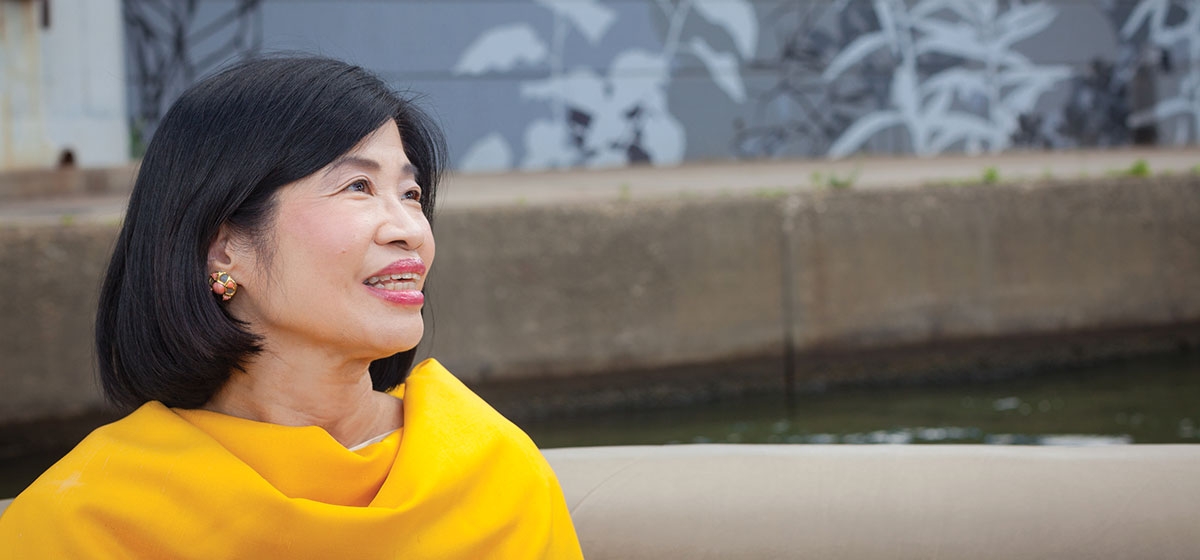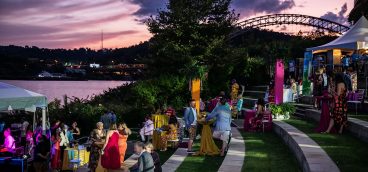
My parents came from educated families in China and Hong Kong and immigrated to the United States. My mother arrived in the early ’50s as an undergraduate while my father, who was 10 years her senior, was studying for a Ph.D. Back then, it was difficult for Asians to come here. The immigration laws were tough.
Ultimately, my parents chose to stay in America. They got married in New York City, where my paternal grandfather had started a business distributing “lo mein” and “chop suey,” what Americans thought of as “Chinese food.” My father was the oldest son and, in his family, the sons were expected to work in the family business. So although he wanted to get a Ph.D. in chemistry, my father never was able to fulfill his dream. Consequently, he and my mother pushed all of their children to become well educated. They believed it was the route to success and fulfillment.
In China, as in many places, a family’s name is carried on by its male members. Our family consisted of my parents, three girls and two boys, of whom I was the oldest—and the first female born in four generations. Traditionally, most Chinese families would have been less than excited by the arrival of a girl. But my parents were progressive and recognized that females, in addition to being good wives and mothers, could and should play other roles in the development and maintenence of culture and society. My mother especially was determined to make sure that her Chinese daughters had the same opportunities as her Chinese sons.
I was born in New York City and remember, as a child, immigration officials coming to our home and asking my parents about other people from China. Those were the days when Joe McCarthy was hunting Communists. China was often referred to as “Red China,” and people would say things like, “Better dead than red.” The immigration officials wanted Chinese nationals who had come here legally to turn in those who hadn’t. My parents, of course, knew many people who had come to the U.S. from China, most of whom were legal, I’m sure. But they were always nervous when the immigration people came, wearing their suits and hats and asking questions. It was scary.
Both my parents wanted their children to attend good schools. They couldn’t afford to send all five of us to private schools in New York City, so we moved to the suburbs of New Jersey, which had good public schools. In 1970, as a 16-year-old student, I experienced the first “Earth Day” celebration with a group of high school students called “Students for Environmental Action.” Eventually, I became the head of that organization. And I must say that, even at such a young age, I was afraid that if we didn’t take action on environmental issues, our generation would not live long enough to see our children be born. During that time, two books made a big impression on me: “The Population Bomb,” by Paul and Anne Ehrlich, and “Silent Spring,” by Rachel Carson, both of which were frightening calls to action. Their messages galvanized me toward trying to make a difference and led me to become involved in the nascent environmental movement.
As high school students, we “environmentalists” were clever enough to mobilize our parents to attend city council meetings with us in Ridgewood, N.J. at which we would stand up and propose ideas such as the establishment of a recycling facility. Eventually, the town agreed to set aside $40,000, which was a lot of money back then, for that purpose. We were doers, and would conduct cleanups in the middle of the night, starting at about 11 p.m. and going to around 12:30 a.m., after which we’d leave signs at the sites we’d cleaned that read: “Nocturnal Ecologists Strike Again,” just to get people’s attention.
I went on to Barnard College at Columbia University in New York (and then later earned a master’s degree at Princeton). My sisters and I all went to Barnard, and they both have master’s degrees from Columbia, and one even went on to get a doctorate from Harvard. My brothers went to good colleges, too, but my parents pushed us girls hard. They wanted us to be good wives and mothers, but also to have fulfilling careers and to be able to support ourselves, if necessary.
“I don’t let myself become immobilized by the fact that there is opposition to progress. Rather, I think to myself, ‘Is there some type of compromise that might satisfy everyone?’”
—Vivien Li
At Barnard, I studied environmental management, which was a combination of biology, geology and geography, and just after finishing the first semester of my freshman year, I got a call from Newark. It seems that someone who had been working in the city planning department on environmental issues was leaving, and they asked if I would be interested in the job, which I was. So I worked there for several years while going to school. During my time in Newark, the project of which I was most proud was executed in conjunction with the Trust for Public Land. There was a vacant lot across the street from City Hall, next to a residential complex, on the ground floor of which was a day care center for the children who lived in the neighborhood, all of whom were African-American. For them, there was no place to play. So I worked with the Trust and the city public works department to convert that vacant lot into a grassy area expressly for the use of those children. Of all the things that I’ve done, that project stands out because it was my first big effort—and because people didn’t believe in it. I was idealistic and there were a lot of barriers: liability insurance, and so on. But when you’re young, you don’t tend to see barriers. You just put your head down and keep moving.
From 1979 to ’81, I worked at the Boston Redevelopment Authority trying to reduce air pollution from problem plants and factories. We had received a grant from the Environmental Protection Agency to engage the managers of those facilities in mitigating air pollution. Between ’81 and ’83, I was at Princeton, and from ’83 on, until I came to Pittsburgh in October of 2015, I worked in Massachusetts, initially for the public health commissioner. Several years later, I worked for Gov. Michael Dukakis (who was running for president at the time) on women’s issues, while assisting with external affairs with constituency groups.
One of the first issues we had to tackle was the question concerning whether or not young women, 16 and older, had to disclose to their parents if they were seeking abortions. The governor had two daughters, and I remember him saying, “Vivien, if my daughter was asking for an abortion, I’d want to know.” Of course, the women in our office said, “Oh, no. What we do with our bodies is our own business,” and so on. So I worked with the governor’s counsel, the National Organization for Women, and with our inter-governmental affairs team to help them understand why legislation on this issue was important—then they lobbied the governor. He really needed to hear different voices, and not just those of females. So some modifications were made to the bill and, when it came to his desk, he signed it. That experience taught me that you don’t just go to the “usual suspects” to get things done. I could have said, “We’re going to mobilize all the women’s groups, because it’s about our bodies,” but it was much more effective to convince some of the men on the governor’s senior staff to tell him, “You know, we really need to respect the fact that women feel this way.”
In 1991, I started work at The Boston Harbor Association (TBHA) to promote public access to and public amenities throughout the harbor and its environs. I wrote promotional articles in The Boston Business Journal and Banker & Tradesmen, both of which were geared toward the business community because I felt that it was important for it, and particularly the real estate community, to understand our perspective. It was in their interest to have a modern and robust waterfront because the more people you have enjoying it, the more opportunities there would be for doing business (i.e., making money) in retail, food and beverages, and so on.
When I first started at TBHA, a lawyer friend said to me, “You should go and meet with the federal judges. They’re talking about possibly siting a new courthouse on Boston Harbor.” Initially, I wrote a piece for The Boston Business Journal saying that, if the judges decide to site a courthouse on the harbor, they must provide various public amenities. In response, I got a handwritten note from Judge Stephen Breyer, who was on the federal 1st Circuit Court (and is now an associate U.S. Supreme Court justice), saying, “Ms. Li, I read, with interest, your article. Would it be possible for us to meet? I want to tease out some of your ideas.” After that, we worked for more than 18 months with the judges, and it was truly a “good cop/bad cop” situation. Judge Breyer would say, “That’s interesting,” while another judge would counter, “We couldn’t possibly do that. Don’t you remember the bombing of the courthouse in Oklahoma City?” Finally, after many meetings, and at the end of one very long session, I addressed the naysaying judge, “With all due respect, the bomb at Oklahoma City was not inside the building; it was outside, in a vehicle. So unless you intend to cut off all roads and streets to the courthouse, you can never prevent such an incident from happening.” Long story short, the judges approved a harbor walk and, to their credit, even after 9/11, added outdoor benches and picnic tables so that people could eat on the property. The courthouse now has a dock for water transportation. It has public restrooms accessible from the outside, and a beautiful outdoor sitting area. It even has public art.
Interestingly, the judiciary became a very important partner for TBHA, especially when it came to the clean-up of Boston Harbor. Not long after I joined the organization, William Weld, the new governor of Massachusetts, began expressing concerns about pollution in the harbor, and about how long it would likely take to clean it up. (Mostly, I believe, he was concerned about the burden on ratepayers, who were shouldering the bulk of the harbor clean-up costs.) I remember calling the federal judge who was presiding over the Boston Harbor case and saying, “It’s very important that you keep all parties on the timetable that has been established, and that you not give in to either the ‘ratepayer revolt,’ or to any political pressure that might be exerted on you.” He listened carefully, and then asked, “So you think this is really important?” I said, “Absolutely.” And he stuck to his guns keeping all parties in line. “We have an obligation,” he later said, “for generations to come, and we’re going to do this.” Today, Pittsburgh is dealing with many of the same issues with which we wrestled in Boston. Potential investors are saying, “For us to do anything here, these bodies of water must be cleaned up.” Be they developers, factory owners or industrial users, we want to hear from them and understand what they need to succeed. If we, at Riverlife, talk only to ourselves, we’re never going to get anywhere.
When I think back to when I started at the TBHA, the lands in question were the former terminus of the freight rail cars (which is where the aforementioned courthouse stands today) and the Charlestown Navy Yard, which was used by the U.S. Navy for naval activities. The housing that’s being built on the terminus to the railroads is now fetching $1,800 per square foot, which means that a 1,000-square-foot condo costs $1.8 million—and they’re getting that. Interest is keen because Boston Harbor is now clean. And that will happen to the riverfront in Pittsburgh, too, as more development occurs, in the Strip District, Lawrenceville, and so on. Did anyone ever think that Lawrenceville would be worth what it is today? In Pittsburgh, some of the most desirable neighborhoods are going to be along the riverfront.
As a point of fact, a number of developers from Boston have made investments in Pittsburgh. The Union Trust Building is being renovated by Jonathan Davis, who grew up in Pittsburgh and has been a developer in Boston for close to 40 years. The project is his first in town. When he took me on a tour of it last fall, he said, “Look at this Vivien. Isn’t this fabulous? Do you know what it would have cost us in Boston to do this?” He bought the building for $14 million, spent $86 million to renovate and upgrade it—a total cost of $100 million—and it just opened in June. And then there’s Corcoran Jennison. They’re doing Oak Hill, in The Hill District—a combination subsidized housing/market-rate housing development. The Hill District is valuable real estate, but local people don’t seem to see it. And let’s not forget Allegheny Center, on the North Side. It was bought by Faros Properties, based in New York, with owners from Boston. They’re spending $200 million on that project—and they’re getting no government money! Down the road, to get a place in Allegheny Center, you’ll be on a waiting list, for sure.
Boston is home to many universities. That’s what makes it so vibrant. And it’s the same with Pittsburgh, and not just Carnegie Mellon and Pitt. All of our local universities contribute to making our city vibrant, too. They draw young people—the future. But today, in Boston, a young person can’t afford to buy a home. They can, however, afford to buy one in Pittsburgh. We have a great quality of life. And the fact that housing is affordable means that young people can come and stay.
Generally, I don’t let myself become immobilized by the fact that there is opposition to progress. Rather, I think to myself, “Is there some type of compromise that might satisfy everyone?” In Asian culture, we are sensitive to the concept of others “losing face.” We want situations always to be “winwin.” We couch things so each side feels that, while they may have given something up, they have come away with something, too. Creating a situation where no one loses is always better because, in life, we don’t just deal with a person or a group of people once. Sometimes people disagree, but we still have to work together. It’s never wise to burn bridges, whether it’s in a big city like Boston or a smaller one like Pittsburgh. Chances are, you’re going to have interactions with the very same people again, about some initiative from which both sides desire something. When you make sure there are no losers, things start to happen.





